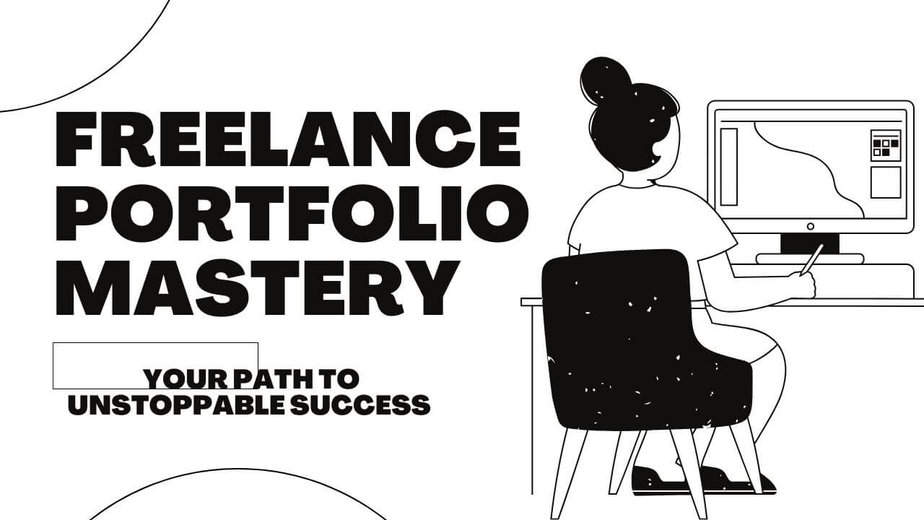Introduction
As a freelancer, your portfolio is your gateway to success. It’s not just a collection of your work; it’s your brand, your story, and your ticket to landing dream projects. In this comprehensive guide, we’ll unravel the art of crafting a freelance portfolio that not only captivates but converts potential clients into loyal patrons.
What Exactly is a Freelance Portfolio?
Imagine your portfolio as a captivating novel about your professional journey. It’s the fusion of visuals and words that narrate your skills, expertise, and unique style. Anyone can claim to be skilled and dependable, but your portfolio proves it.
Why a Freelance Portfolio is so Important?
Why is your freelance portfolio so crucial? In the world of freelancing, where every project is a leap of faith for clients, your portfolio acts as the safety net. It does two vital things:
- Compelling Presentation: Through visually stunning content and compelling storytelling, your portfolio makes your value proposition irresistible.
- Trustworthy Evidence: It offers undeniable proof that you can deliver on your promises, turning that initial skepticism into trust.
Picture this: You have a potential client in front of you, teetering on the edge of a decision. Your portfolio, if wielded effectively, can tip the scales in your favor.
But building a powerful freelance portfolio isn’t just about showcasing your work; it’s about strategically presenting yourself to potential clients. It’s the magic wand that transforms a casual visitor into a paying client.
Why a Freelance Portfolio is better than a Resume?
You might wonder, “Isn’t a resume enough?” The short answer: no. While resumes work for traditional jobs, they fall short in the dynamic world of freelancing. A resume tells your story, but a portfolio shows it.
For creative professionals – artists, writers, designers, photographers, and more – a portfolio is worth its weight in gold. Words can describe your work, but seeing it in action is a game-changer. For instance, if you’re an illustrator, showing your art speaks volumes more than listing your qualifications.
Moreover, your freelance portfolio isn’t just a static presentation; it’s a dynamic tool. It’s your personal stage, where you not only display your work but also market yourself. You can seamlessly integrate marketing and SEO features, making your portfolio discoverable by potential clients. And with features like contact forms and booking systems, you can turn casual visitors into loyal customers right from your portfolio website.
Creating a Freelance Portfolio that Draws in Clients
Building a portfolio from scratch might seem like a daunting task, especially if you’re relatively new to the freelance world. However, that initial trepidation can be a sign of opportunity. Most freelancers share your fears, and many of them haven’t ventured into the discomfort of creating an exceptional portfolio. But you’re different, and that’s what can set you apart as top talent.
Design Your Freelance Portfolio with a Niche in Mind
To capture your audience’s attention, you must speak directly to them. In your early freelancing days, you might stumble upon highly competitive job listings, like the one that had 50+ proposals. Generally, you’d follow the rule of bidding only on jobs with fewer than 15 proposals to avoid fierce competition. But for this job, you made an exception.
Your proposal began with a personal connection: “Hi there! Fun fact: I used to own a carpet cleaning business.” Remarkably, you got the job. What are the odds of that? You were a newcomer on Upwork, with only one previous job on the platform, and you competed against seasoned “Top Rated” freelancers.
Would you have succeeded without sharing that personal link? Unlikely. Speaking directly to your potential clients, addressing their specific needs, and showing a connection is powerful.
Choosing a niche for your portfolio provides a double advantage:
- Immediate Client Attraction: You catch the eye of the right clients and gain their trust and confidence before saying a word. A targeted portfolio is far more enticing than a generic one.
- Expertise Development: Becoming a top-tier specialist in one niche is easier and quicker than trying to master multiple areas. For instance, specializing in veterinary clinic website design allows you to excel rapidly in this niche.
Select a niche and don’t fear missing out on clients outside it. It’s better to excel within a niche than to perpetually struggle for clients because you aimed to please everyone.
Display Your Practice Projects
What if you lack a wealth of portfolio items? Create your projects. You’ve designed something, and even a few projects suffice. Don’t hesitate to ask friends or family if they need a website or graphic materials. You can offer these projects for free if you’re starting out. The lessons learned during these initial projects are invaluable before approaching potential clients.
Outline Your Process
Explaining your process sets you apart from other freelancers. It showcases your confidence, organization, and precision. This “Process” section is a golden opportunity to highlight the value you offer. Consider coining a phrase for your process, making it feel unique and proprietary. For instance, describe your “4-D Process” for creating websites:
- Define
- Design
- Develop
- Deliver
Each phase adds a layer of distinction and demonstrates your commitment to excellence.
Specify the Types of Projects You Seek
Let potential clients know what projects you’re interested in. Clarify your niche, just as you did in your portfolio. When visitors to your portfolio see descriptions matching their needs, they’re more likely to choose you over more experienced freelancers.
Tailor your portfolio by showcasing 3-5 projects that align with your preferred work. These should be the projects you truly enjoy and want more of.
Showcase Previous Client Projects (If Any)
If you have past client work, present it thoughtfully. Include a story with each project:
- Define the primary problem you solved.
- Explain how it affected the client’s business.
- Describe your problem-solving approach.
- Share the client’s reaction and the impact on their business.
Collecting this data might require ongoing communication with former clients, but it’s worth it. It not only enhances your portfolio but also sparks ideas for improving your business.
Highlight Your Education and Experiences
Your history, including schooling, courses, certifications, and personal experiences, contributes to your brand. Freelancers aren’t just hired for their skills; clients also seek professionals who are communicative, punctual, positive, and pleasant to work with.
List your industry-relevant skills and education prominently. Clients want to hire skilled, sharp, and amiable freelancers who align with their values.
Incorporate Testimonials, References, or Case Studies
Social proof should permeate your portfolio. It’s like the seasoning on popcorn – don’t let it fall to the bottom. Include testimonials, both written and video, references, and case studies. Social proof in various forms builds trust and credibility.
Your portfolio is your gateway to a thriving freelance career. By following these tips, you’ll craft a portfolio that not only impresses but also converts potential clients into loyal patrons. Now, let’s explore even more ways to enhance your freelance portfolio and boost your freelancing journey to new heights.

Promoting Your Freelance Portfolio: Where and How
So, you’ve got an impressive body of work, and you’re eager to showcase it to potential clients. But how do you effectively promote yourself in the crowded freelancing landscape? The answer lies in strategically chosen portfolio websites. Here, we’ve compiled some of the best options to help you navigate the sea of possibilities. If you have a personal favorite, don’t hesitate to share it in the comments!
Let’s start with the straightforward Clippings.me. It provides a user-friendly platform to display your work. After setting up your profile, you can add a profile picture, contact information, and a brief introduction. Your portfolio is neatly organized into categories, each accompanied by pictures and publication details.
Clippings.me offers a free version, but for $4.99 per month, you gain access to useful extras like custom domain support, a listing in their journalist directory, and portfolio analytics tools.
Contently primarily connects freelancers with high-quality writing jobs, but it also offers an excellent free portfolio service. Setting up your portfolio here is a breeze. You can link your published articles, and Contently automatically fetches them. You choose which pieces to include, and your work is elegantly displayed in a grid, complete with social sharing statistics.
Designed specifically for journalists, Journo Portfolio offers a selection of themes and extensive customization options. You also get access to copyright-free images to enhance your portfolio’s visual appeal. It offers three packages: Free, Plus, and Pro. The Plus and Pro versions provide more features like unlimited articles and your custom domain.
Medium is a unique platform that aggregates content from various contributors, making it a popular choice to showcase your work. It’s user-friendly, requires no coding skills, and offers basic formatting options. Writers can create profiles, and readers can easily find your entire portfolio. Membership costs $5 a month or $50 a year, granting access to unlimited articles.
Muck Rack is polished and professional, with an emphasis on connecting journalists with PRs and companies. Each writer profile contains an overview, work samples, and any awards you’ve received. You can integrate your Twitter feed into your profile, making it a comprehensive representation of your work and online presence.
Pressfolio is similar to Journo Portfolio but with a focus on simplicity. It offers templates and themes for customization. The Lite package costs $9.99 per month and includes domain hosting, back-ups, and PDF uploads, while the Pro package adds web traffic stats and other features.
Squarespace provides an easy-to-use, visually appealing platform for creating your portfolio site. Starting at £10 per month, it offers templates and drag-and-drop elements to customize your portfolio to your liking.
Writerfolio offers a variety of templates and themes to make your portfolio stand out. For $4 per month, you get unlimited hosting for your samples and scans, and you can use your custom domain if you have one.
This straightforward option is ideal for those who prefer simplicity. For £5.49 a month, you get a simple portfolio with unlimited clippings and support.
About.me serves as a professional landing page with a background photo, pertinent information, and links to your work. The Pro version, at $6.58 per month, provides your domain, removes About.me branding, and offers customer support.
Tumblr is a straightforward, fast-publishing platform with fewer customization options but no charges.
WordPress is highly versatile, offering free, paid, and self-hosted versions. It allows full creative control with thousands of themes and customization options. If you’re willing to learn some CSS, you can truly make it your own.
Selecting the right platform for your portfolio depends on your specific needs and preferences. These options cover a range of features, so take the time to explore them and choose the one that best represents your work and personal brand.
Conclusion
As a freelancer, your portfolio is more than a showcase; it’s your calling card, your personal brand, and your ticket to new opportunities. So, whether you’re a seasoned pro or just starting your freelancing journey, make the most of these portfolio platforms to stand out in a competitive market. Your next client may be just a click away, ready to be impressed by the portfolio that tells your unique story. Happy freelancing!



1 thought on “Freelance Portfolio Mastery: Your Path to Unstoppable Success”
Pingback: Cold outreach simplified : How to get clients through cold emails | Moinul - The Happy Nerd